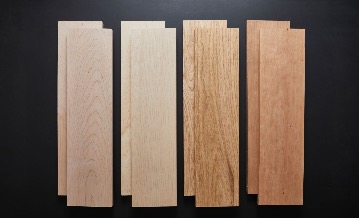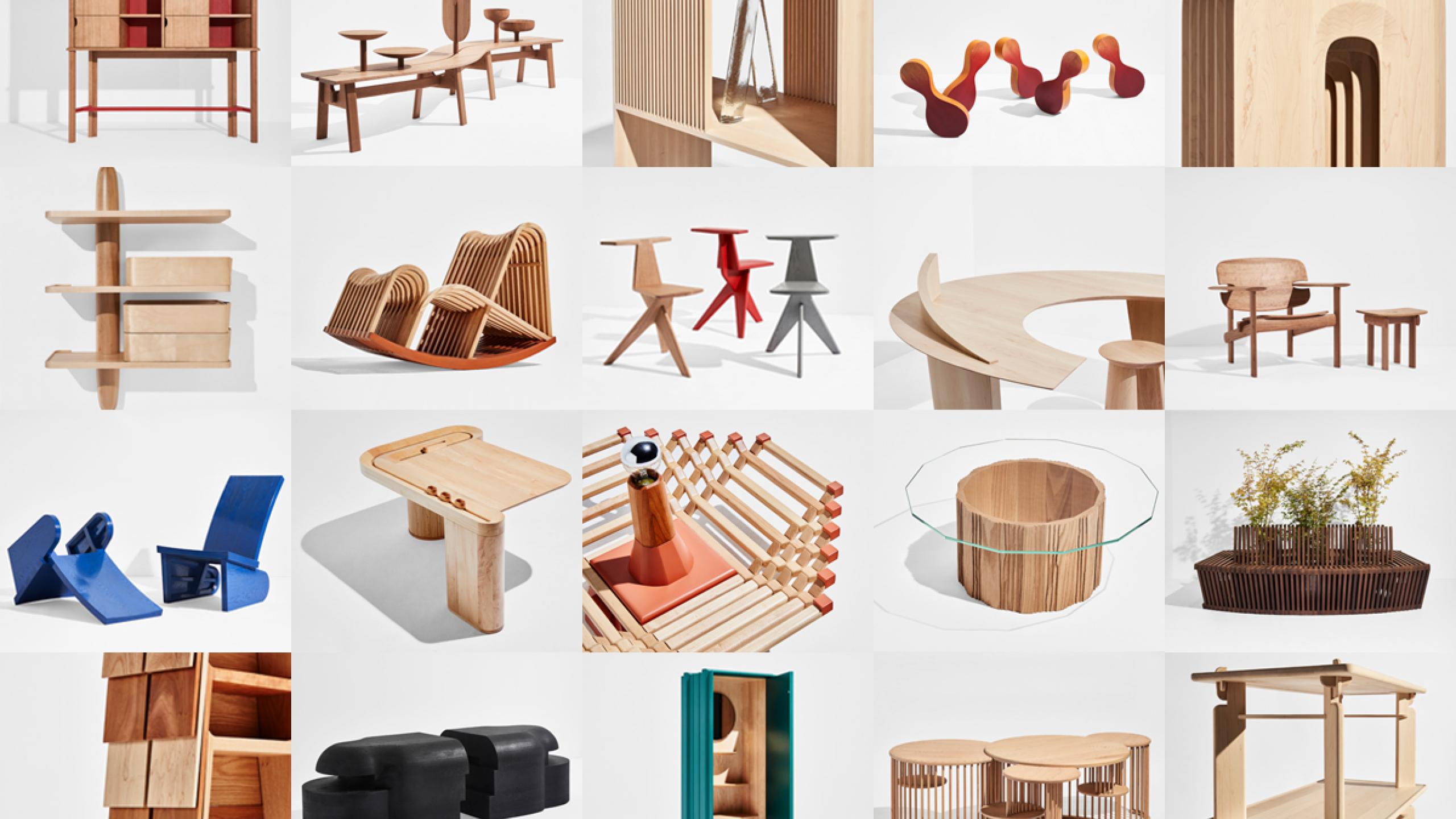Home > Our Projects > AHEC and Wallpaper* present Discovered – a showcase of emerging international talent
AHEC AND WALLPAPER* PRESENT DISCOVERED – A SHOWCASE OF EMERGING INTERNATIONAL TALENT
Made in isolation
13 September to 10 October
This September, the Design Museum plays host to a global showcase of the next generation of design talent. Bringing together 20 emerging designers from 16 countries, Discovered presents a visionary group of young creatives from across Europe, Africa, Asia and Australasia in an extraordinary showcase of furniture, objects and sculptural works in wood.
A collaboration between the American Hardwood Export Council (AHEC) and Wallpaper* magazine, Discovered offers a series of personal reflections on the experience of the pandemic, while providing a platform for new creatives after a year in which the usual channels for exposure were inaccessible. The exhibition is therefore a much-needed opportunity for emerging designers to get their work out there in front of the public and the industry.
The designers have worked alongside design mentors to each develop a new object made from their choice of four sustainable hardwoods: American red oak, cherry and hard and soft maple.
Throughout the project, designers have been supported and mentored by Wallpaper* editor-in-chief Sarah Douglas and by AHEC’s European director David Venables, as well as a global group of designers including Tomoko Azumi, Maria Jeglinska-Adamczewska, Nathan Yong and Adam Markowitz.
“Discovered is a unique opportunity for us, as we will be joining forces with the other AHEC regional offices in a creative project for the first time. Together with Wallpaper*, we have selected an extremely exciting line-up of designers from 16 different countries – 5 of whom are from Southeast Asia and China. This project has enabled us to give them a valuable learning experience on product design and development with sustainable hardwood. We are also fortunate to have had input from Designer Nathan Yong as a mentor for the SE Asia and Greater China designers. Added to this has been world-class manufacturing from Fowseng in Malaysia. It’s a great opportunity to showcase the capability of Southeast Asian & Chinese design on a global stage”
– John Chan, Regional Director AHEC Southeast Asia & Greater China
To develop their concepts, participants were invited to think freely about their experience of living and working in isolation, responding to themes of touch, reflection and strength, and to channel their own experiences into a piece that represents our functional and emotional connections to everyday objects. The designers have considered ideas such as identity and cultural heritage, family and social ritual, the pandemic-induced need to adapt, and the inherent comfort of touch.
This has resulted in a highly diverse selection of objects, ranging from functional furniture such as cabinets, tables and chairs to more abstract, sculptural works that inspire reflection. Taken as a whole, Discovered represents how the experience of isolation has inspired each designer’s personal and creative journeys, in what has been an extraordinary time for the individual, the industry and the world as a whole.
Designs and designers
Yunhan Wang – Winding Stream
Zhuhai, China
Wood: American hard maple
Unable to carry out certain customs during lockdown, people are confined to performing rituals at home. There is a novel need for suitable furniture and objects that can fit a small space but serve the same purpose. Wang wanted to create a domestic alternative to the ‘winding stream party’, a Chinese drinking custom in which poetry is composed while a cup is floated down a stream with people sat on both sides; the person sitting in front of the cup that stops has to drink it. Inspired by Hakka round houses, Wang created a compact table design with storage concealed in the legs and a central slit to fit trays and cups. The table is also equipped with a drain so users can dispose of their water through the twisting gully, and it then trickles into a waste bucket housed in the main leg. Wang chose hard maple for Winding Stream because she was drawn to the light colour, and the timber has been spray-painted to prevent rot from setting in.
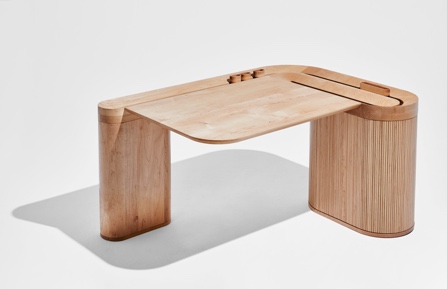
Tan Wei Xiang – Recollect
Singapore
Woods: American hard maple, red oak
Searching for a tangible physical connection to loved ones (beyond virtual calls), Tan turned to keepsakes as a way to fight nostalgia. His keepsakes cabinet is imagined as a way to hold, preserve and give respect to the items we hold dear. Its forms were inspired by Singapore’s ubiquitous construction sites and the ridged zinc sheets used to protect them. Tan recreated this motif as the outer shell of his tall, lean cabinet, and created curved shelves to sit inside it, with a mirrored, polished brass circle, mimicking the sun setting on the horizon. The designer had worked with maple before but never from the American hardwood forests and, for this project, he selected a combination of hard maple of different thicknesses to achieve the ‘crinkled’ effect on the shell, and red oak for the curved shelves inside.
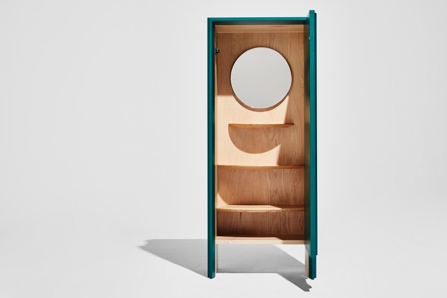
Trang Nguyen – The Roof Stool
Ho Chi Minh City, Vietnam
Woods: American cherry, red oak, hard maple
Nguyen looked at traditional Vietnamese roof tiles for her project, creating a collection of nesting stools that replicate the way the tiles overlap to hide the connecting structures below. Her simple stool design is inspired by traditional temple architecture and Vietnamese dresses, and features pins made of contrasting wood at the joint, which remains hidden when the stools are stacked and is revealed when they are in use. ‘I chose three different types of wood; cherry, red oak and maple, because of their colour differences,’ explains Nguyen. ‘By randomly using two of the species for the pins and another one for the rest for the stool, users can explore the various timbers when they unstack each piece.’ As people have been spending more time at home, her design is imagined to provide additional seats, while creating a beautiful composition when not in use.
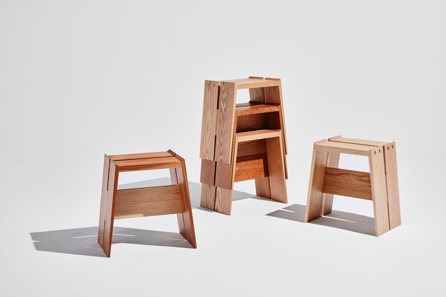
Nong Chotipatoomwan – Thought Bubble
Bangkok, Thailand
Wood: American red oak
A nostalgia for travel and social interaction guided Chotipatoomwan’s creative thinking through her project. Physical transitions were replaced with changing states of mind, and the physical realm merged with the psychological realm through domestic space. The designer looked at furniture created for relaxation, and landed on a rocking motion, which became the basis for her chair, offering a mix of relaxation and repetitive movement to enhance mindfulness. She used red oak for the chair because she was fascinated by its grain. ‘It’s quite expressive and I was interested in its porous nature.’
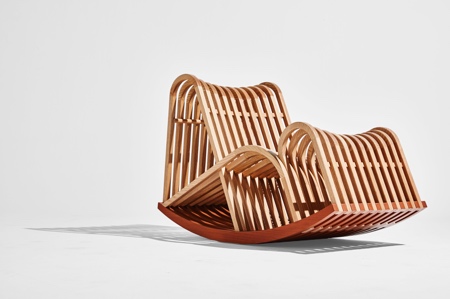
Mew Mungnatee – Corners Lamp
Bangkok, Thailand
Woods: American soft maple, cherry
Mungnatee’s emotional response to the objects surrounding her took in the relationship between form, light and shadow, and with this project, she explored this connection through geometry. Her lamp designs, inspired by pagodas, are based on a bulb casting a shadow over surfaces below thanks to an intricate grid composition featuring wooden slats and indented corners. She worked with soft maple, because of the manner in which light bounces off its surface (‘The wood has an opalescent gleam,’ she explains) and American cherry for its ability to take stain.
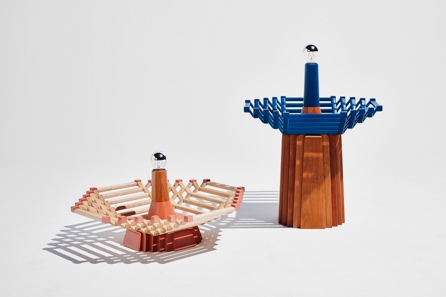
Duncan Young – Shelter Within
Adelaide, Australia
Wood: American hard maple
Young focused on the materiality of timber, and how this organic material can help us connect with nature while confined at home. ‘For those in dense urban environments, lockdowns have impacted our physical and mental strength by limiting the biological need humans have for being in outdoor spaces,’ he says. He looked at studies analysing the positive impact of nature on physical and mental health, and in response created a modern cabinet of curiosities as a pillar to nature, for the user to engage with the natural world while at home. Featuring a solid carcass with discreet joinery and a moiré-effect shelf (a design inspired by the historic symbolism of the cabinet as a theatre), the simple plinth includes two glass sculptural elements handmade at Young’s studio, refracting and distorting the light to evoke the effect of walking beneath a canopy of trees. Young used hard maple to create the carcass. ‘It’s such a pared-back timber,’ he explains. ‘It has a gentle grain structure and I thought the lightness would soften the heaviness of my piece’s form.’
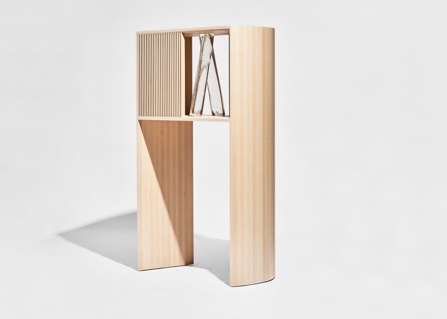
Vivienne Wong – luxta Me (Beside me)
Melbourne, Australia
Wood: American cherry
Dancer-turned-designer Wong looked at non-verbal communication as the starting point of her project, approaching the task from a personal point of reflection and knowledge. ‘I wanted to translate my previous understanding of how we can connect and communicate,’ she says, and looked to create a piece to nurture strength, intimacy and connection. Invisible physical boundaries and the creation of textures through light formed the basis of the project, which developed into a coffee table featuring interlocking echoed forms, where the functional joinery also became a decorative motif for the piece. Wong chose American cherry because of its grain and colour. ‘It has a beautiful warmth in its pinkish, red hue,’ she says. ‘I felt that supported everything I was trying to put into this piece.’ Her design’s name (using the Latin word for ‘beside’) represents the desire for human connection and closeness that guided the process.
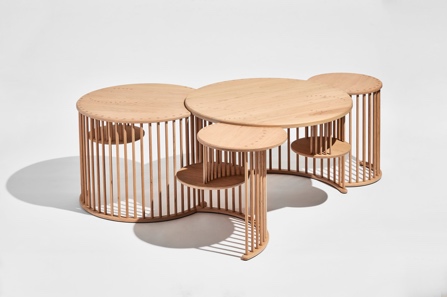
Sizar Alexis – Lahmu
Eskilstuna, Sweden
Wood: American cherry, scorched red oak
Having lived through the Iraq war in the 1990s, Alexis imagined his home as a bunker, protecting his family and newborn son during the pandemic. Drawing from the similarities between his own childhood experience and his young son’s, his sculptural pieces are defined by stark monolithic forms and stillness, representing the emotional connection to his thoughts in the pandemic. The chunky volumes serve as side tables or stools, and together as a bench or low sideboard, inspired by bunker architecture. Alexis chose two contrasting woods: one half of his piece is in American cherry, for its warmth, and one half is in red oak, its surface burned with a scorching technique.
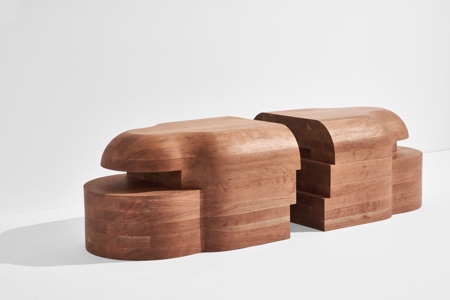
Isabelle Baudraz – Presences
Lausanne, Switzerland / Athens, Greece
Wood: American cherry
Fighting a feeling of isolation, Baudraz recreated tactile and emotional connections through her four objects. Inspired by the idea of bringing natural movements and forms into the home, her collection comprises two suspended mobiles, a desk object, and a wall-mounted installation designed to create moments of tactile connection during isolation. Her pieces are made of American cherry: ‘It was an instinctive choice,’ she says. ‘We received all these beautiful samples from AHEC and I was touched by the colour of the cherry and the texture of its grain. I also liked the fact that it was going to evolve and get darker with age.’
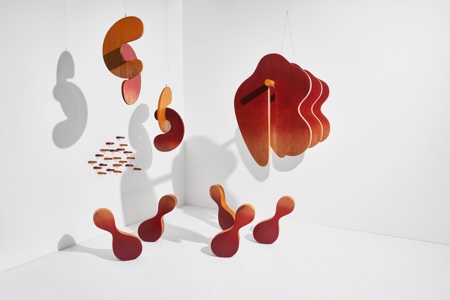
Mac Collins – Concur
Newcastle, UK
Woods: American cherry
While the term ‘isolation’ has acquired negative meaning over the past 18 months, Collins takes a more positive view. ‘For me, the word has always carried romanticised connotations of contentment, serenity, contemplation and a sense of withdrawal from the rigmarole of socially prescribed routine,’ he says. During his time alone, books became precious companions, and this inspired him to create a place for reflection and reading. His lounge chair and bookrest, a ‘companion object’, encourage the sitter to tune out of daily life and focus on an analogue task. Collins chose cherry for his chair, aiming to create a welcoming, warm and inviting place.
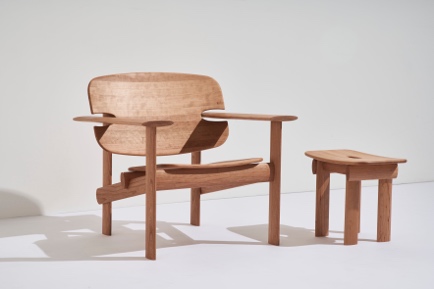
Siyanda Mazibuko – Kumsuka (Evolve your space)
Johannesburg, South Africa
Wood: Thermally modified American red oak
The inspirations for Mazibuko’s piece included isicholo, a hairstyle symbolising tribal identity in several African cultures, and indlamu, a tribal Zulu dance practised in celebratory ceremonies. He paired these visual references with a reflection on themes of engaging, human behaviour, and the role of design in people’s lives. ‘Engaging with other people is an intrinsic human trait,’ he says, citing this as the reason for his design, a modular, layered seat imagined for public spaces. He took a practical approach, looking into ergonomics and function to create his bench, composed of interlocking strips of thermally modified red oak – timber that has been baked to a high temperature, making it suitable for the outdoors.
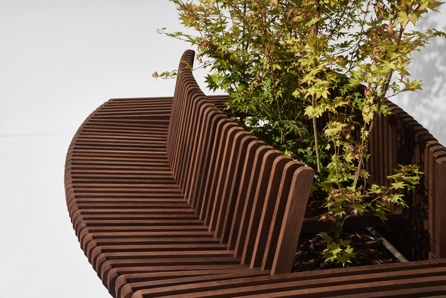
Josh Krute – Toteemi
Helsinki, Finland
Wood: American hard maple
Inspired by totems (toteemi meaning ‘totem’ in Finnish), Krute created a multifunctional storage system. As domestic spaces get taken over by work materials during time at home, Krute imagined a series of stackable boxes to stow work supplies and small objects, while other components serve as a side table, tray or stools. The design features a ‘lip’ that serves as a handle, and each box has a different colour on the inside, providing them with a distinguishable character; Krute chose hard maple because of its light hue and ability to take colour. The modular system explores tactile wooden objects, birdhouses and small structures, which Krute streamlined into a compact, practical design. ‘Toteemi provides solutions for how we delve between living and working in the same environment,’ he says.
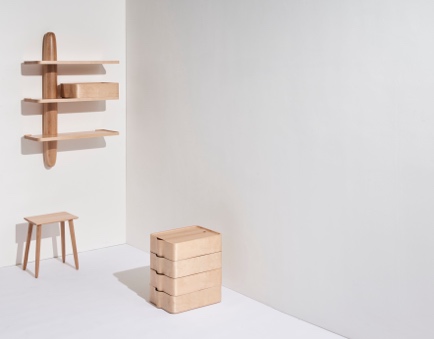
Kodai Iwamoto – Pari Pari
Tokyo, Japan
Wood: American red oak
For his project, Iwamoto researched traditional Japanese techniques, such as uzukuri (giving texture to wood by scrubbing) and chouna (chiselling the surface with an adze), and then started experimenting directly on the wood, peeling its layers to create a new veneer. Working with red oak, he peeled it by cutting the panel’s edge and removing the surface by hand, resulting in a jagged effect where the texture of the grain emerges. These imperfectly textured panels became the starting point for a design exploration that led him to a round table shape, using the subtle material as a base to create the effect of an ancient tree trunk.
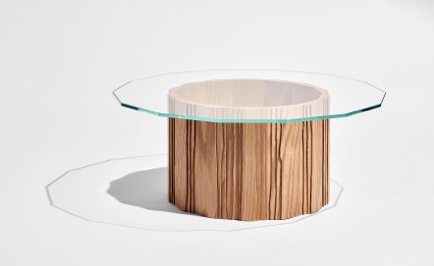
Pascal Hien – Migo 01
Berlin, Germany
Wood: American red oak
‘The pandemic was a time for pause and reflection, when we became more present with ourselves and our surroundings,’ observes Hien. His object, a versatile stool, is the result of the designer’s reflections during a time of change and uncertainty, learning to adapt and tune out of his fast-paced life. The stool represents this ever-changing existence: ‘you can adapt it in various ways, there is no front or back, no right or wrong.’ It’s a helper around the house or a place to sit. He chose red oak for its strength and worked on a design with a rational construction: each chair is made from a single plank of red oak (so you get consistency of grain), and its parts are held together with dovetails. While living with his family during the pandemic, Hien involved them in the testing of the piece, for the first time making them a part of his design work.
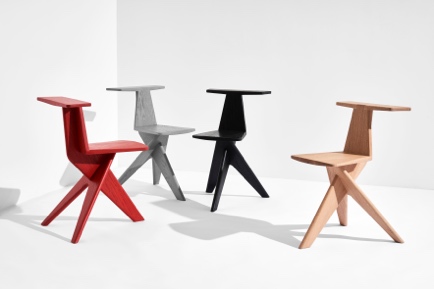
Alessandra Fumagalli Romario – Studiolo 2.0
Milan, Italy
Wood: American cherry
During extensive Zooming, video meetings and Insta-lives, Fumagalli Romario observed people’s curated backgrounds, which got her thinking about ‘the importance of objects as extension of ourselves: from one side, many boundaries are created, from another, boundaries disappear, private and public are mixed together’. She likened this curated space to the small studioli found in Renaissance paintings, and to cabinets of curiosities. Inspired by this, she created a visual background, a cabinet to present oneself through objects that may be exhibited or hidden. Adding to its intrigue, she angled the vertical planes that divide the cabinet; together with gradient finishing, this creates the illusion of greater depth. Of her cherry wood choice, she says, ‘I wanted a wood that talked by itself. Also, I love its warm colour. It’s a wood that changes colour quickly if exposed to light. It’s important nowadays to have objects that remind us that they come from nature and change and mutate over time.’
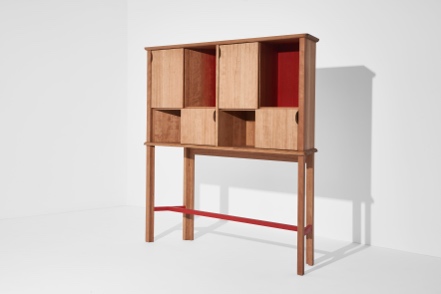
Taiho Shin – Ikare
Seoul, Republic of Korea
Wood: American hard maple
During his time in isolation, Shin noted that ‘objects help human resilience through unusual situations’, and this thought served as the basis for his project. Guided by the ‘Ikea effect’ (consumers place higher value on products they partially created), he thought of a half-made design that users could partly assemble to foster interaction with their objects. He created one small table, put together thanks to an ingenious but simple-to-use joint system (no glue necessary), and the design multiplies to create a stackable system of shelves, suitable for different spaces. He chose hard maple, as the density of the timber means the joint can be moved in and out without crushing the fibre of the wood.
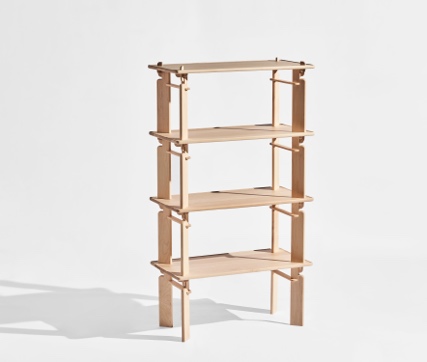
Mimi Shodeinde – Howard desk
London, UK
Woods: American hard maple
The pandemic world is all about newness, observes Shodeinde: new dangers, and new ways of interacting, living and working. ‘In designing furniture for this new paradigm,’ she says, ‘we should lean into the familiar and the comforting. We should seek freedom, connection, stability and strength.’ These qualities are to be found in her design: a solid desk whose light forms contrast with the rigorous construction and weight of the hard maple. The designer looked to a vast pool of cultural references, from the compositions of British sculptor Barbara Hepworth to the modernist architecture of Lina Bo Bardi, and the aerodynamics of flight (pilot Howard Hughes inspired the name of the piece): these influences converged into a sinuous silhouette, a design that challenges the familiar but also offers a sense of safety.
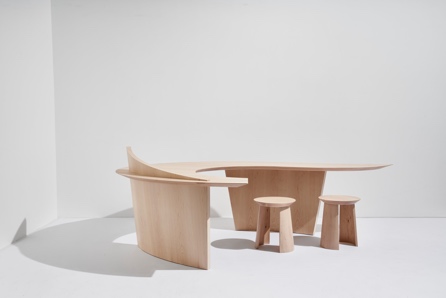
Juan Carlos Franco & Juan Santiago Sierra – Riverside bench
Colombia, Spain
Wood: American cherry
During isolation, objects change their function and their meaning, and we find ourselves looking for space within our space. This was the observation that kicked off Franco and Sierra’s project, which looks at how our furniture changes purpose and how adaptability is key (in a pandemic as much as in modern living). Inspired by adaptable design (such as the pile dwellings, or stilt houses, in Colombia), they created a bench that suits different needs, thanks to the addition of accessories such as trays, dividers and storage that fuse into a central fissure. This way, the bench becomes a multifunctional space that can adapt to home, workspace or public environment. The designers chose cherry for their piece: ‘We’d never worked with cherry before, and it was a great opportunity to take advantage of that wood,’ says Sierra. ‘Also, we saw what our mentor, Maria Jeglinska-Adamczewska, did with her table and chair in AHEC’s previous project, Connected. It was made from cherry and it was really beautiful: we loved the grain and the texture.’
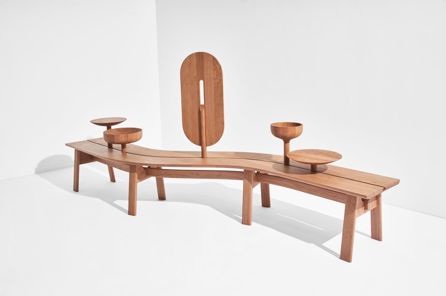
Ivana Taylor – Reframe
Adelaide, Australia
Woods: American hard maple, cherry and red oak
Taylor’s own experience of solitude led to extensive periods of reflection, ultimately inspiring her to change her approach to designing and making. For this project, she aimed to ‘design a contemplative sculptural object that triggered reflection on the multi-layered nature of any experience, including isolation’. A recurring theme of her research featured ways of framing a view at different scales, and the resulting design is a sculpture made from a series of small carved objects that layer to create a composition acting as a ‘sculpted path for light’. Working with three woods, Taylor was interested in exploring different material hollows, cutting each layer to expose the wood’s grain.
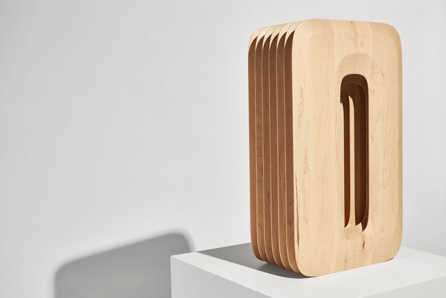
Martin Thübeck – Rå
Stockholm, Sweden
Wood: American red oak
While confined at home with his young children, Thübeck found inspiration in the way they adapted their surroundings for play, challenging conventional ways to use furniture: ‘Limitations became possibilities,’ he comments. After looking at traditional furniture and playground equipment, he developed a piece (Rå, meaning ‘pure’ in Swedish, also referring to a mythical forest creature from local folklore that can change its appearance) whose construction is informed by Swedish craft, and whose function can be interpreted either as a chair or a slide, as it is flipped upside down. He chose red oak for his design, based on the way the wood soaks up pigment and gives depth to it. ‘This piece is a symbol of coexistence, and the act of turning it is like moving between worlds,’ he says, citing an approach that merges the indoor and outdoor, staticity and movement, adults’ and kids’ points of view. ‘My intention is not to fully merge the two functions, but to see what happens when they are so close to each other that they are perceived as one,’ he says.

Notes for editors
American Hardwood Export Council (AHEC)
For over 30 years the American Hardwood Export Council (AHEC) has been at the forefront of wood promotion in Europe, successfully building a distinctive and creative brand for U.S. hardwoods. AHEC’s support for creative design projects such as Connected, Legacy and MultiPly for the London Design Festival demonstrate the performance potential of these sustainable materials and provide valuable inspiration.
AHEC has pioneered the modelling of environmental Life Cycle Assessment (LCA) for hardwoods, an approach that has since been adopted by other industries. LCA measures a number of impacts: primary energy demand (from renewable and non-renewable resources); global warming potential; acidification potential; eutrophication potential; and photochemical ozone creation potential.
About the material
American red oak
Warm, grainy, tough and bendy, full of character.
Reaching a height of 21m, with a trunk diameter of 1m, red oak is the most abundant species in America’s hardwood forests. Named for the colour of its leaves in the fall, this classic oak wood has a light brown sapwood, and a heartwood characterised by attractive warm reddish-pink tones. Red oak is strong, straight grained, coarse- textured and distinctive. Its porosity makes it a premium wood for bending and staining.
American maple
Light, fine, hard and incandescent, a bright choice.
A close cousin of European maple and sycamore, American maple can reach heights of between 23-27m, with a trunk diameter of 75cm. For the purposes of this project, we are grouping the botanical subspecies, hard and soft maple, which share similar characteristics and are both relatively abundant. Hard maple is a cold climate species favouring the northern states, whereas soft maples grow more widely across the mixed hardwood forests of the eastern United States. Both hard and soft maple produce syrup.
American cherry
Rich, smooth, vibrant and flexible, a craftsman’s delight.
A medium size tree, reaching a height of around 20m, cherry has a relatively short rotation, taking less time to mature than other hardwoods. The narrow sapwood is a light pinkish colour, while the heartwood varies from rich red to reddish brown, and darkens on exposure to light. American cherry had a long period of popularity in furniture making, it became less popular but is on the verge of a revival.
